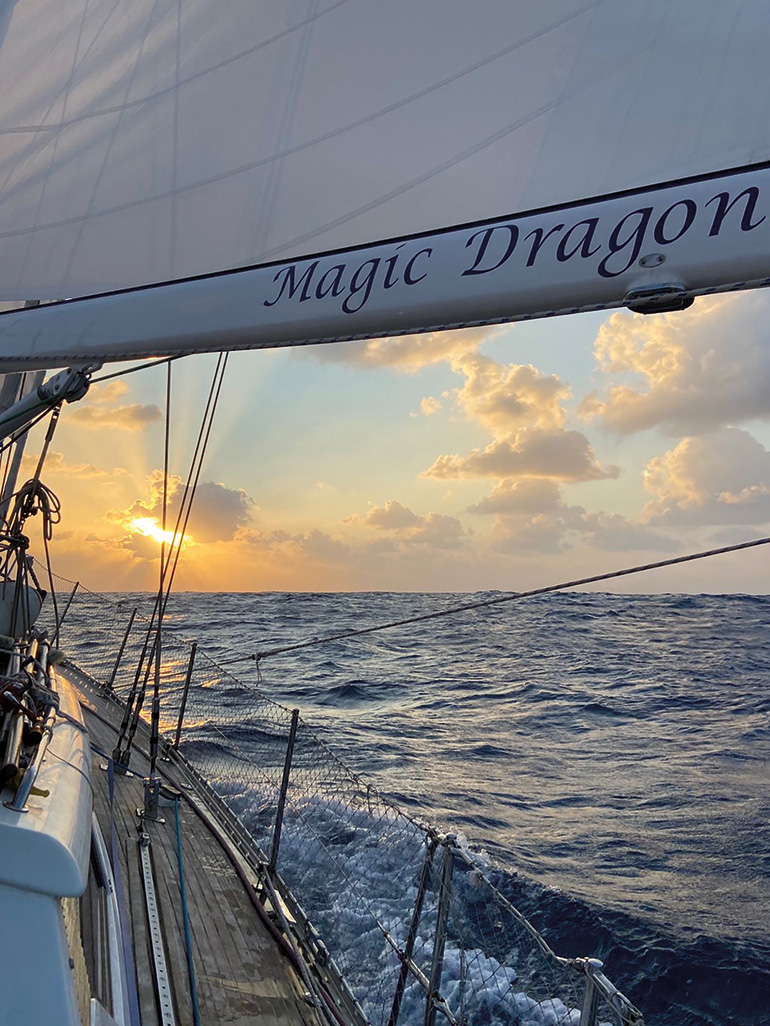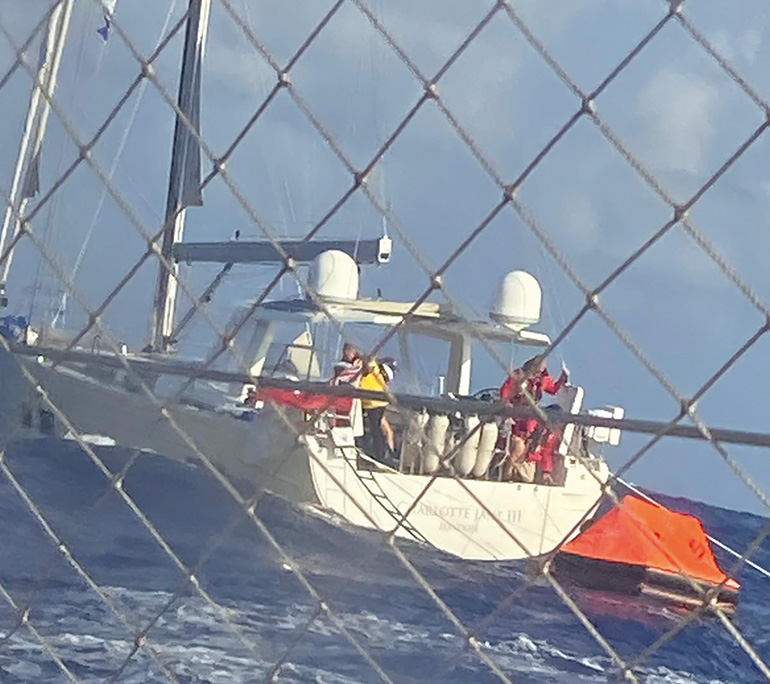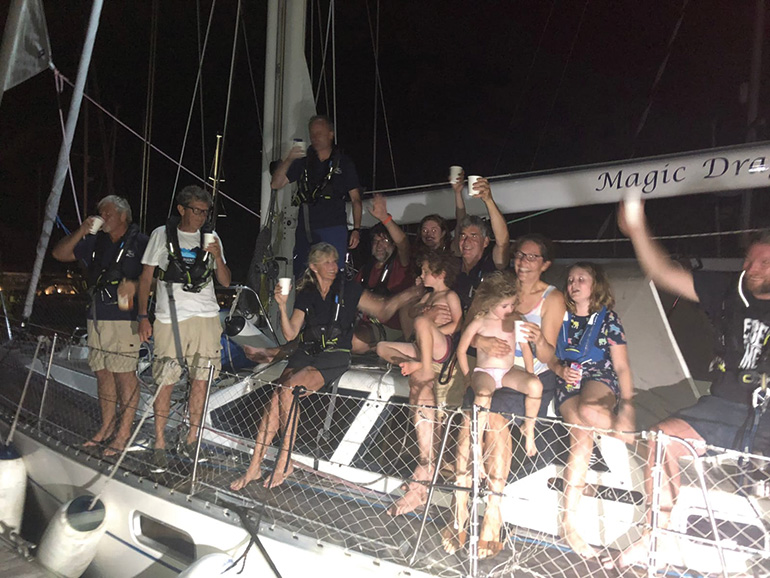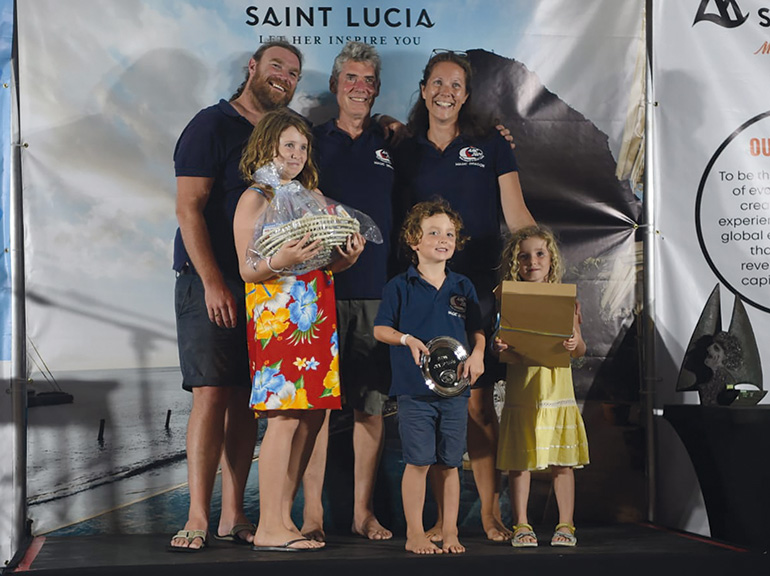Sport | Posted on January 28th, 2022 | return to news
EXCLUSIVE: Adventure of a lifetime turns into heroic mission
Bournemouth man, Craig Gray, recounts a dramatic event during his experience aboard a yacht in his first ARC race across the world’s second-largest ocean.

I was awoken at 9am sharp by nine-year-old Dorothy.
“Craig, there’s been a mayday, you have to get up,’ she whispered, almost apologetically, through the half-open door to my cabin.
I mumbled something incoherently, but probably close to ‘OK, OK, I’m coming’ while blearily fumbling for some clothes, and my watch or phone to ascertain exactly what time it was. I had the blinds pulled across the hatches to the foredeck as I’d finished my watch at 0730ish.
I had indeed only been asleep about an hour, but a mayday is a mayday.
We were just under 1500 nautical miles (about 1720 ‘regular’ miles) east of the Caribbean island of St Lucia, smack in the middle of the Atlantic ocean, some 10 days into my very first transatlantic crossing. The yacht, Magic Dragon of Dart was a 1994 built 55 foot Oyster, a fantastic, stable, seaworthy and safe vessel owned and skippered by Rod Halling and his wife Jane.
Alongside the three of us was Lizzie, 26, Rod’s daughter from a previous marriage and an excellent dinghy sailor; Dorothy, nine, and twins Peter and Vera, four years old – the latter three kids both Rod’s and Jane’s. It was a real family affair, and I was incredibly lucky to be part of it.
I think it’s safe to say the passage wasn’t proving to be quite the ‘milk run’ many thought it would be in the days leading up to our departure. We were sailing with the Altlantic Rally for Cruisers (ARC), on an annual event involving around 150 yachts, all setting sail from Las Palmas, Gran Canaria to St Lucia at the same time, in a kind of ‘light-hearted’ race.
Some pretty fierce upwind sailing conditions on the most direct route across forced many boats to sail South along Africa’s West Coast, before turning west around 17 degrees north to skirt the top of Cape Verde, and catch the more predictable, calmer easterly trade winds.
It didn’t take long for those reliably calm downwind trades to pick up however, and they remained around a blustery Force 5 and 6 for the majority of the voyage. Add to this some seriously large and confused swell of around four metres plus, and you do not get a particularly comfortable fortnight’s sailing.
Aside from myself, the entire crew of Magic Dragon were prone to a little seasickness, and although every preventative measure was taken, in rough seas as we had there are no guarantees.
A week in and things were beginning to heat up, quite literally, as we sailed further into the tropics. The 26-30 knots from astern gave some respite, but hat, sunglasses and Factor 50 was the order of the day. The tricky swell, and unpredictable movement of the boat, meant that sleep was at best fitful, and only compounded any feelings of illness.
Our newly installed watermaker had also inexplicably stopped working, leaving us with a little over 400 litres to sustain us for the 10 or so days left aboard. This obviously did little to boost morale, although I must admit I was having the time of my life. How often does one get the chance to sail a large blue-water yacht in rough seas across the world’s second-largest ocean?
Around this time we received news that one of the yachts that took the more northerly route had had some serious trouble, resulting in the death of a crewmember. Although information was limited at the time, it turned out the French vessel Agecononix accidentally gybed, fatally hitting crewman Max Delannoy and injuring another. The yacht had to be abandoned and the surviving crew evacuated. Another blow to morale.
With all this in mind we sailed on, Magic Dragon making short work of the conditions and running beautifully on a goosewing at around 10-12 knots. The weather got worse and by the 30th we were experiencing five or six major squalls a day with winds around 35/40 knots. Poor Lizzie encountered one on her night watch, with over 50 knots hammering us from all angles, and it was all hands on deck to get the main away and reef the genoa.
It was the morning of 1 December when we received Charlotte Jane III’s mayday. It had been another rough night with several squalls and although my watch ended at 0600, I stayed up until about 0730 to keep an eye on another yacht on our radar with Lizzie.
A minute or so after Dorothy had woken me, I staggered, still half asleep, into no small chaos. Jane was at the chart table in radio contact with Charlotte Jane’s skipper, with the kids running around the saloon incredibly excited at all of the kerfuffle. I glanced up the companionway to see Rod at the helm with Lizzie beside him. I enquired as to the emergency.
“A yacht’s lost its rudder. We’re going to help. They’re about six miles away,” said Rod, calm and matter-of-fact as ever. Although I could feel the large and frequent swell, I popped my head up to check the conditions.
A beautiful, sunny morning, plenty of wind, and that same unpredictable and dangerous swell as bad as we’d had so far, if not worse. Certainly no place to lose your steering, 1,500 nautical miles away from anywhere.
Once I’d gotten my bearings, I set to work on deck. We furled away the mainsail and genoa, centred the boom and motored towards our target at around six knots, the wind around 30 degrees off our starboard bow.
It was only once we turned into the wind to get the sails away I fully appreciated how strong it was. Force 7, gusting to Force 8, and showing no signs of easing up. I took the helm while Rod went below, Magic Dragon driving through the family-home-sized waves with ease, white spray across the deck. I’d be lying if I said it wasn’t an exhilarating way to wake up.
The 58-foot Hanse and her crew had been bashed around with no steering all night long, and seemed to have made the incredibly difficult decision to abandon ship. There were two other ARC yachts standing by, but neither had space for all five passengers. In spite of our broken water maker, we decided it was more important to simply get them off their boat, we’d figure out the water issue later.

Rod, Jane, Lizzie and I, discussed a plan for rescue. Coming alongside was out of the question due to the conditions and we considered heaving-to upwind of them, leaving Charlotte Jane alee of us. Then the crew would get into their life raft, cast themselves off, and we would pick them up out of the water.
A couple of days before the rally began, we all took Magic Dragon for a test sail, and, in the outer harbour of Las Palmas, spent a couple of hours refreshing our man overboard manoeuvres. It was while formulating our plan that we all looked at each other with the same thought: ‘I’m so glad we did that practise.’
It took around an hour to reach the stricken vessel, during which time we talked through the manoeuvre, rigged lines and ladders on the expected lee side, and focused on the task at hand. The children, even the four year olds, seemed to realise the gravity of the situation and behaved absolutely impeccably.
At about 1030 we approached the scene and Jane once more got on the radio. As we got closer, Lizzie and I sat amidships on the portside, lifejackets on, safety lines attached, and we watched Charlotte Jane’s crew moving around her stern.
One man threw out the life raft, which after 30 seconds or so of tugging, inflated beautifully. The yacht was pointing across the wind as their drogue, or sea anchor, held her in position. This meant the crew jumping into their life raft from the open transom, which, due to the swell was at times four or five metres above the water. All we could do was watch as the first man picked his moment to leap.
Finally a gap in the waves arrived and he pushed himself off the yacht, landing perfectly in the raft. We all cheered, such was the release in tension, but I did wonder if it was the time or the place.
A few bags full of food were launched in behind him and, one by one, the other four crewmembers followed suit. Once all in (relative) safety, the painter was cut, and slowly Charlotte Jane III drifted away from her crew.
Our plan to heave-to was scuppered by both the conditions and the 80 metre drogue line, and Rod had to motor around the beleaguered yacht, keeping a fair distance and point upwind using the engine. This he managed superbly as only a skipper in full confidence and control of his own boat can, and Lizzie and I switched lines over in preparation to pick up the crew on our starboard side, to windward.
We let them come to us, but with the swell only getting heavier, I began to worry that they’d be crushed underneath our hull. Somehow Rod kept the life raft amidships, and once they were within about 10 feet, I stood up to throw them a line. It wasn’t lost on me that this was my most important job right now, and the consequences of a bad throw could at best prolong this already dangerous situation and at worst, be practically disastrous. I’ve always had an active imagination.
I put all this to the back of my mind and threw the line, perfectly through the open life raft hatch, and into the arms of Paul, the skipper. He then, through some heroic feat of strength, did not let go until every other person was safely on-board Magic Dragon.
Now the next important job began: lifting the crew out of the raft. The guardrail was open and various ladders and lines were laid over the side, but getting those people safely on deck was no mean feat.


First up was Richard, who managed to grab on at just the right place and I had little trouble in helping him aboard. Next was Jonathan, not the smallest man in the world, and he unfortunately ended up climbing further astern where the guardrail was highest. I grabbed his arm, said something stupid like ‘you’re getting on this boat,’ and through adrenaline and sheer brute strength, dragged him into the cockpit.
Charlotte, Paul’s wife and a slight lady was next, and after the previous exertion, I nearly threw her over the boat and back into the sea. Charlie came up after, along with a few bags of food and belongings, and finally skipper Paul could let go of that rope and be reunited with his friends and family as Charlotte Jane III drifted away into the distance.
I can’t imagine how hard it must be to watch your boat, your pride and joy, disappear over the horizon, unmanned, with very little hope of ever seeing her again. Although, to look around and see your wife and three best friends all alive and well, albeit wet and shaken up, must be some small consolation.
We had been in contact with JK Sail, one of the boats standing by, who were aware of our water situation and offered to try and send some bottles over on a fender and line. Although quite exhausted from the crew transfer, we decided to give it a try. After a couple of passes with no success we called it off, the conditions were still bad enough to question rescuing a man overboard, let alone a few bottles of water.
Jane put the kettle on and immediately shifted into hostess-mode. We turned Magic Dragon into the wind to bring her sails out, and got ourselves back on course for St Lucia.
The rest of the journey was, thankfully, entirely without incident. Being a decent engineer, Paul even managed to get our watermaker working after a couple of days, meaning showers for everyone, and no more water rationing.
With all the extra food our guests brought with them, we ate like kings for the remainder of the journey, and with extra hands on board everyone could double-up on watches. Morale generally improved all-round, in spite of the Atlantic still giving us a good kicking all day and night: that swell still refusing to let up the whole way.
And so it was that late evening on Thursday 9 December 2021 Magic Dragon of Dart arrived at the marina in Rodney Bay, St Lucia, to rapturous applause and a fanfare of hundreds of foghorns and cheers. The entire place turned out to see us in, with the families of our extra crew awaiting them at the berth.
As soon as the final line was set, the crew of Charlotte Jane III leapt from the deck of their rescuers and straight into the arms of their loved ones, who, although well aware of the survivors’ wellbeing, yearned to hold them close for final, tangible, proof of their safety.
It took another week before the majority of yachts crossed the finish line. On the Friday night, as the ARC prize-giving ceremony drew to a close, the organiser announced: “The final award this year is the ‘Spirit Of The ARC’, and goes to an individual or crew that has displayed selfless commitment in helping others in the rally… Despite already having seven on board, including three children, they risked their safety to evacuate Charlotte Jane’s crew, and eight days later delivered them safely to the shores of St Lucia… This year’s ‘Spirit Of The ARC’ goes to Magic Dragon of Dart!”
This award was merely the icing on the cake of what had been an experience never to be forgotten. Around 3,200 nautical miles of confused seas, uncomfortable conditions, ghostly squalls, glorious sunsets, hazy sunrises, unparalleled camaraderie, unexpected friendships, and weeks of blue waters as far as the eye can see.
I am incredibly proud to have been a part of Magic Dragon’s crew, and will forever be indebted to my adopted sailing family.
Please share post:









